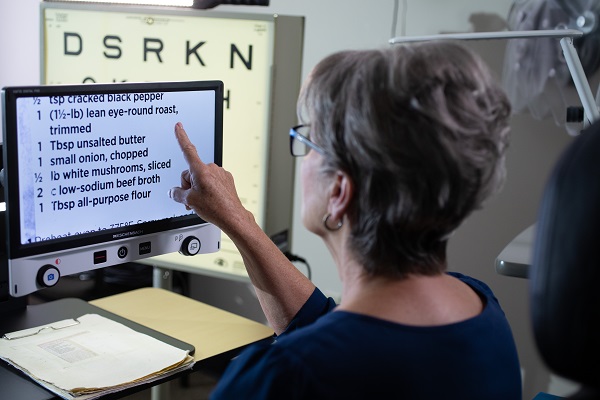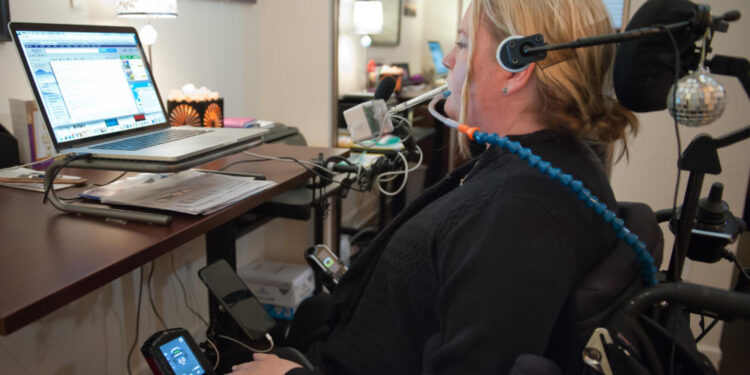Assistive technology is an umbrella term that includes assistive, adaptive, and rehabilitative devices for people with disabilities and also includes the process used in selecting, locating, and using them. Assistive technology promotes greater independence by enabling people to perform tasks that they would otherwise be unable to do or have difficulty doing. Some examples of assistive technology devices are: wheelchairs, walkers, prosthetic limbs, communication devices, computer software and hardware (e.g., screen readers, alternative keyboards), environmental control systems (e.g., door openers), and vehicles modified for driving (e.g., hand controls).
Assistive technology is any type of device or system that can be used to improve the functional abilities of individuals with disabilities. This can include everything from simple tools and adaptations, to complex computerized systems. Assistive technology can be used in all sorts of activities, including communication, education, work, and daily living tasks.
Individuals with disabilities often face many barriers in their everyday lives. These barriers can make it difficult or even impossible to do things that many of us take for granted. Assistive technology can help to remove some of these barriers, and allow people with disabilities to lead more independent and fulfilling lives.
There are assistive devices available for just about any activity you can think of. For example, there are devices that can help with communication, such as special phones or software that convert text to speech. There are also devices that can assist with mobility, like motorized wheelchairs or scooters.
And there are devices that can help with daily living tasks like bathing, dressing, and eating.
The use of assistive technology is not just limited to people with physical disabilities. There are also products available for people who have cognitive impairments or who are blind or deaf.
In fact, there’s really no limit to the types of disabilities that can benefit from assistive technology!
If you think you might benefit from using assistive technology in your life, don’t hesitate to reach out for more information and resources. There are lots of great organizations and websites dedicated to helping people find the right products for their needs.
And remember – even if you don’t have a disability yourself, you may know someone who does!
What is Assistive Technology in Education
Assistive technology in education can mean different things to different people. For some, it might be a simple as a text-to-speech program that reads aloud for students who have difficulty reading. For others, it might be a more complex system that includes an augmentative and alternative communication device (AAC) to help students with severe communication difficulties participate in class.
Whatever the form, assistive technology in education is designed to level the playing field for all students by providing them with the tools they need to succeed academically.
There are many benefits of using assistive technology in education. Perhaps the most obvious is that it can help students with disabilities access the curriculum and participate fully in class.
In addition, assistive technology can also help struggling learners keep up with their peers, and it can be used as a preventive measure to avoid problems before they start. For example, if a student is having trouble reading, using a text-to-speech program can help them catch up before they fall behind.
Another benefit of using assistive technology in education is that it can promote independence and self-advocacy skills.
When students have the tools they need to be successful, they are more likely to feel confident and competent in their abilities. This increased sense of self-efficacy can lead to greater independence both inside and outside of the classroom setting. Additionally, using assistive technology often requires students to advocate for themselves and their needs, which is an important life skill.
If you’re interested in exploring how assistive technology could benefit your child or student, there are many resources available online or through your local school district’s special education department. Assistive technology doesn’t have to be expensive or complicated – sometimes even small changes can make a big difference!

Credit: www.envisionus.com
What Do You Mean by Assistive Technology?
Assistive technology is any type of technology that can be used to increase the independence of someone with a disability. This could include anything from simple devices like grab bars and ramps to more complex items like computer software and adaptive equipment. The goal of assistive technology is to help people with disabilities live as independently as possible.
There are many different types of assistive technology, and what works for one person may not work for another. It’s important to find the right solution for each individual, as this can make a huge difference in their quality of life. Some common examples of assistive technology include:
Wheelchairs: Wheelchairs are perhaps the most well-known type of assistive technology. They provide mobility for those who cannot walk, and can be either manual or electric.
Computer software: There are many different types of computer software available that can help people with disabilities perform tasks that might otherwise be difficult or impossible.
For example, there are programs that can convert text to speech, which can be very helpful for someone who is blind or has low vision. There are also programs that can provide on-screen keyboard access for people who cannot use a standard keyboard.
Adaptive equipment: Adaptive equipment is any type of device that helps people with physical disabilities perform everyday tasks.
For example, there are adaptive eating utensils available that allow someone with limited use of their hands to eat independently. There are also adaptive clothing options available that make it easier to dress oneself without assistance.
These are just a few examples of the many types of assistive technology available today.
With so many options out there, it’s important to work with an experienced professional to find the best solution for each individual’s needs.
What is an Example of Assistive Technology?
Assistive technology (AT) is any type of technology that can be used to enhance the functional abilities of individuals with disabilities. AT can range from low-tech tools like adapted utensils and magnifying glasses to high-tech devices like computerized speech synthesizers and powered wheelchairs.
One example of assistive technology is an adaptive switch.
Adaptive switches are designed to be operated by people with limited movement or dexterity, and they can be used to control a wide variety of devices, including computers, toys, and power wheelchair motors. Another example of AT is software that allows people who are blind or have low vision to access information on a computer screen using text-to-speech or Braille output.
What is the Main Purpose of Assistive Technology?
Assistive technology is any type of technology that can be used to enhance the functional abilities of individuals with disabilities. It includes devices and services that are used to maintain, improve or increase the functional capabilities of people with disabilities. Assistive technology can be used by people of all ages, from infants and toddlers to adults.
There are many different types of assistive technology devices, and they can be used for a wide variety of purposes. Some common examples include:
* Communication aids such as augmentative and alternative communication (AAC) devices, which can help people who are unable to communicate verbally.
* Mobility aids such as wheelchairs, walkers and scooters, which can help people who have difficulty walking or moving around.
* Educational aids such as computer software and adaptive equipment, which can help students with learning disabilities succeed in school.
* Environmental control devices such as switches and remote controls, which can help people with physical disabilities access their surroundings.
* There are also a number of assistive technology services that can provide support and assistance to users of AT devices. These services can include assessment, training, maintenance and repair.
What is Assistive Technology for Students?
Assistive technology (AT) is any type of device or system that can be used to enhance learning, communication, and/or mobility for students with disabilities. AT can range from low-tech items such as pencil grips and magnifiers to high-tech items such as iPads and alternative communication devices. The use of AT can help level the playing field for students with disabilities, allowing them to access the same curriculum and educational materials as their peers.
There are many different types of assistive technology devices, and each one can be tailored to meet the specific needs of an individual student. Some common examples of AT include:
Alternate communication devices: These devices provide a way for students who cannot speak or have difficulty speaking to communicate with others.
They may include picture boards, voice output systems, or text-to-speech apps.
Adaptive computer technologies: These tools make it possible for students with physical disabilities or limited fine motor skills to use a computer. They may include eye-tracking software, ergonomic keyboards, or single switch input devices.
Mobility aids: These devices help students who have difficulty moving around independently to get around more easily. They may include wheelchairs, walkers, scooters, or standing frames.
What is Assistive Technology (A.T.)
Conclusion
Assistive technology (AT) is any type of device that helps people with disabilities perform daily tasks. AT can range from simple devices, such as canes and magnifiers, to complex systems, such as computer-based communication tools. The goal of assistive technology is to improve the quality of life for people with disabilities by providing them with greater independence and autonomy.








